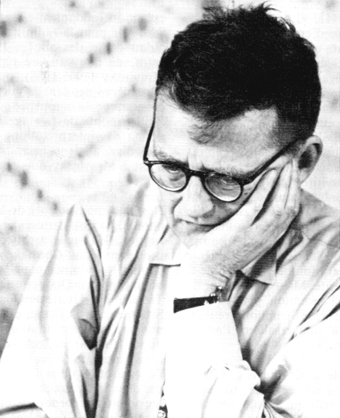Composed 1964; 27 minutes
The five movements of Shostakovich’s Ninth Quartet seamlessly evolve from one into another, without break, but with a profound underlying logic. The opening movement is built around two themes. The first is anxious and pressing on the violin over low, held notes from the viola and cello. The second, using similar thematic material, is a quirky little march from the cello, lighter and airier and somewhat enigmatic. Development of these two ideas gives way to a short but deeply felt Adagio, based on a solemn, modal theme. As it concludes, a fragment of the modal theme is spun into the bouncy opening of the succeeding scherzo (Allegretto). This driving movement has an arch-like form (A-B-C-B-A) that mirrors the overall five-movement shape of the quartet itself. The bouncy violin figure then morphs into a rather melancholy rocking figure at the beginning of a second Adagio. This slow movement has something of the character of a recitative, twice punctuated by harsh, pizzicato chords. Much of the weight of the quartet is contained in the finale which is twice as long as previous movements. It opens with great forward momentum and has the shape of a large-scale sonata structure. Themes and fragments from earlier in the quartet are revisited and forged into a brusque fugue. Its progression is interrupted by the anguished recitative from the previous movement, now played by the cello. More harsh pizzicato chords from all the instruments lead to an energetic recapitulation where the bouncy violin theme from the scherzo drives the music forward with a sense of finality.
 Russian composer Dmitri Shostakovich’s last decade was marked by a long and painful withdrawal from public life, ending only with his death in 1975. This turning inward affected his music. Increasingly, he chose to write chamber music, completing seven deeply personal quartets in the same period that he wrote just two works in the more public forum of the symphony. As he confronted the bleak prospects of both personal mortality and state repression, Shostakovich sought out private truth and eternal spiritual values through the small-scaled, intimate and often complex world of the string quartet. As his musical language grew more elusive, the integrity of his vision appears more acute and defined. It was a profound journey, comparable to that of the deaf and isolated Beethoven.
Russian composer Dmitri Shostakovich’s last decade was marked by a long and painful withdrawal from public life, ending only with his death in 1975. This turning inward affected his music. Increasingly, he chose to write chamber music, completing seven deeply personal quartets in the same period that he wrote just two works in the more public forum of the symphony. As he confronted the bleak prospects of both personal mortality and state repression, Shostakovich sought out private truth and eternal spiritual values through the small-scaled, intimate and often complex world of the string quartet. As his musical language grew more elusive, the integrity of his vision appears more acute and defined. It was a profound journey, comparable to that of the deaf and isolated Beethoven.
The Ninth and Tenth quartets, related to one another and both written in 1964, mark the beginning of this journey.
— All program notes copyright © 2024 Keith Horner. Comments welcomed: khnotes@sympatico.ca